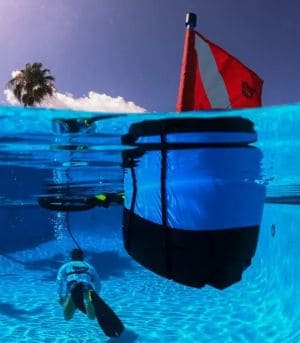Home › Scuba Diving Information › Scuba Diving Blogs › SNUBA vs. SCUBA
What is SNUBA® and How Does it Work?
SNUBA® was first developed in the early nineties. It's a tankless dive system that helps to bridge the gap between traditional snorkeling and scuba diving.
But, what does SNUBA stand for and what are some of the key advantages of using SNUBA instead of scuba diving or snorkeling?
SNUBA Diving vs. SCUBA Diving Explained
You would be forgiven for thinking that the SNUBA acronym is a clever combination of snorkeling and scuba.
But, SNUBA stands for Surface Nexus Underwater Breathing Apparatus.
Although it continues to be very popular in the Caribbean and Hawaii, it struggles to compete worldwide with other mainstream popular water-based family adventures, especially scuba and snorkel swimming.
That being said, many will see SNUBA as the smallest dive system, and an activity that takes traditional snorkeling to the next level.
SNUBA® is a worldwide licensed product resort activity. The programs that use this product are only offered through certified SNUBA Recreational Centers (SRCs) which adhere to strict licensing requirements and operating procedures.
Still, SNUBA diving fills the gap for some adventure travelers that surface snorkeling does not offer. Diving down and breaking the surface with a SNUBA system allows you to experience the three-dimensional underwater world - while breathing comfortably through a scuba regulator.
Air Supply
Scuba divers are 'independent' underwater because they wear a scuba cylinder on their back. The compressed air stored inside the metal tank allows them to breathe through a special regulator attached to it by a short hose.
But, snuba divers don't need to carry anything on their back because the breathing air is supplied by a device on a floating raft at the surface. Thus, they breathe through a long hose connected to it, so they will be tethered to the raft above them.
Depth Limits
The sea-level support raft supplies air through a long tube attached to multiple regulators, reaching a maximum depth of about six (6) metres.
Whereas, recreational scuba divers can go to 40 metres (130 feet) with the proper training, such as from PADI, CMAS, or SSI, and the necessary safety equipment.
 SNUBA divers appreciate the comfort and security of joining a small close group monitored by a safety guide throughout the underwater tour.
SNUBA divers appreciate the comfort and security of joining a small close group monitored by a safety guide throughout the underwater tour.
Thus, if you crave more excitement than traditional snorkeling, but you're sceptical about scuba diving, SNUBA is super easy to learn and you do not need to have any previous experience or certification.
The activity can be enjoyed by nervous swimmers and novice snorkelers, which means it's accessible to families with children and seniors who may have never snorkelled before.
So, Who Goes for a SNUBA Dive?
Certified scuba divers promote it as an introduction to the sport to their non-certified friends and potential dive buddies. Plus, SNUBA Doo® is the program that also allows children from four (4) years old to participate.
There are some similarities in both of these water-based activities. But, whether 'SNUBA or Scuba' is best for you will be a matter of personal preference.
You will receive a twenty minute safety briefing and get geared up with your SNUBA diving equipment, including a mask, diving fins, weight belt, and a safety harness.
Following that, you will be breathing and swimming underwater with ease and controlled comfort supplied by your certified SNUBA Guide.
Even though you have range and depth limitations, this is a relatively simple adventure that gets you close to the coral reef formations and swimming among the vibrant marine life.
In a nutshell, the main advantage of SCUBA vs. SCUBA is the mobility and freedom that divers have to explore sunken shipwrecks, get access to deeper reefs, and to have longer submersions.
SNUBA vs. Snorkeling
Breathing System
When you go snorkeling you will be breathing through a snorkel tube while you're at the surface. Even though your face is in the water, your body stays at or near the surface - unless you hold your breath and dive down for a brief moment.
Whereas, the snuba rig allows you to breathe compressed air through a scuba regulator. So, all things being equal, you will be able to stay underwater for a lot longer, without having to hold your breath.
Depth Limits
In general, snorkeling is an activity that takes place at the surface, with an occasional "duck dive" down to a few metres. Snuba usually takes place in shallow bays at a depth of six or seven metres below the surface (25 feet).
Training and Experience Level
Even when you're learning how to snorkel without swallowing water there is no formal training required, only a few simple swimming survival skills.
By comparison, you would need to attend a brief instruction session before you make a snuba dive - even though no certification is needed.
Snorkeling is more popular with beginners and young children who may be scared of deep dark water. Snuba is an ideal way for adventurous beginners to see what lies below the surface until they feel ready to earn a scuba diving certification.